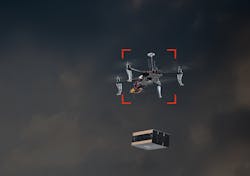Drone mitigation is a major challenge when it comes to protecting the airfield.
Hobbyists and bad actors alike create an extremely dangerous situation at an airport if they fly a drone into a flight path or into a secure area.
Dedrone and the FAA recently announced an expanded partnership to grow testing and use of counterdrone technology at airports in the U.S. as the agency looks to enhance safety at airports. The technology is still in early days of deployment in the U.S., but airports cite drone incursions as one of their top security concerns.
Dedrone CMO Mary-Lou Smulders explains more about what counterdrone technology is and how it works in an airport setting.
What Does Counterdrone Technology Mean?
Drones have enormous potential to benefit society —making deliveries greener and faster, acting as a first responder in emergencies, making agriculture more efficient, capturing footage at events, providing entertainment. When a drone is being used for a more malicious purpose, like causing havoc or damaging a critical infrastructure site, then law enforcement, security professionals and militaries need ways to detect, track, and identify these drones, then mitigate the threats where possible. Airspace security technology enables productive drones to fly and keep people, property and information safe from malicious or careless drones.
What Makes Drone Detection Difficult at Airports?
Drone detection at airports is not necessarily difficult, but it does have specific requirements. Passive drone detection technology tends to work best so as not to interfere with other technologies in use at the airport. Passive technology like RF detection “listens” for specific frequencies, then matches them to known communication protocols of drones.
There are drones in use at some airports. For example, bringing spare parts from a maintenance shed directly to a plane. Any drone detection technology at an airport needs to be able to whitelist specific ‘good’ drones to ensure no unnecessary interruptions to approved drone activity.
How Does Counterdrone Technology Work?
Units like the DedroneTracker takes inputs from multiple sensors including RF, radar, video and acoustics and confirms drone presence. It then determines the location of both the drone and its pilot. It then provides autonomous AI-driven results for drone location, threat intelligence on the drone as well as pilot location and best possible mitigation options.
What are the Human Roles in this Technology?
Humans make the final decision on if and how to mitigate drones as well as retrieve drones and perform investigations or pilot interactions.
What Technology is on the Market to Detect Drones?
Counterdrone platforms can integrate information from cameras, radio frequency sensors, radar or acoustics.
How Does Counterdrone Technology Know It’s a Drone?
The DedroneTracker uses AI data and imagery databases. The AI-driven algorithms, 18 million image library and DedroneDNA are all proprietary assets used by Dedrone and trained over years of flight detections to provide DedroneTracker with the ability to identify drone models (or DIY drones) and virtually eliminate false positives.
What Does Drone Mitigation Entail?
There are 4 basic ways to do this:
· Have the pilot bring the drone down: In the U.S., this is the only legal path that State, Local, Territorial, and Tribal (SLTT) law enforcement agencies have today to stop a drone.
· Jam the drone: Jamming a drone creates a virtual wall between the remote and the drone, stopping the drone from receiving a signal. In this case, the drone is programmed to fly back to its take-off location. This is a non-invasive way to stop a single drone or a drone swarm without any physical damage to the drone or its surroundings. Dedrone offers two RF jammers: DedroneDefender and DroneDefender .
· Hack the drone: Certain technologies can directly hack into and take control of a drone. This allows security teams to land the drone in a safe location of their choosing.
· Kinetically affect the drone: This category of drone mitigations refers to physically affecting the drone in some way and includes everything from falcon capture, drone net guns, kamikaze drones and more.
Methods 2-4 are not allowed to be used by SLTT today in the U.S., because drones are offered similar protections under the law as a commercial airplane full of people.


